
The Syngnathidae is a family of fish which includes seahorses, pipefishes, and seadragons. The name is derived from Greek, σύν (syn), meaning "together", and γνάθος (gnathos), meaning "jaw". This fused jaw trait is something the entire family has in common.

Pipefishes or pipe-fishes (Syngnathinae) are a subfamily of small fishes, which, together with the seahorses and seadragons, form the family Syngnathidae.

Syngnathus is a genus of fish in the family Syngnathidae found in marine, brackish and sometimes fresh waters of the Atlantic, Indian and Pacific Ocean. Fossils of these species are found from the Oligocene to the Pleistocene. They are known from various localities of Greece, Italy, Germany and United States.
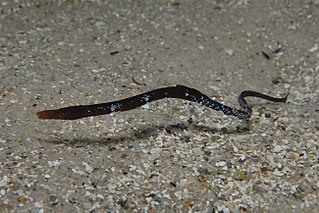
Histiogamphelus is a genus of fish known as the crested pipefishes. They belong to the family syngnathidae and are endemic to the southern coast of Australia and Tasmania. They have a characteristic "crest" on the snout, which can help distinguish them from other related genera within the sub-family Syngnathinae. Their brown-tan coloration may mimic the Posidonia sea grass in which they are often found. Like all syngnathids, the male broods the eggs in a brood pouch.
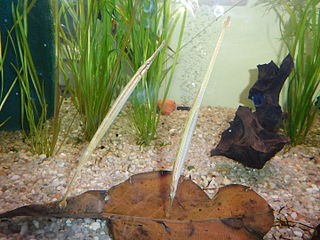
Microphis is a genus of pipefishes within the family Syngnathidae. Members of this genus are notable among the Syngnathidae for residing in mainly fresh and brackish waters. Adults breed in coastal rivers, streams, or lakes, and fertilized eggs are carried by the male pipefish in a brood pouch extending along his entire ventral surface.

Corythoichthys is a genus of pipefishes of the family Syngnathidae. All species in the genus are found in the tropical Indian and Pacific Oceans on reefs or rubble bottoms. Relationships and taxonomy within the genus are still in debate, but there may be at least 23 species.

Dunckerocampus is a genus of pipefishes one of two genera known as the flagtail pipefishes. This genus is native to the Indian and Pacific Oceans where they are usually found in reef environments. These species are elongated and have a maximum length between 10 and 20 centimetres, with D. chapmani being the only species with a maximum length below 15 centimetres (5.9 in). Their tail is red with a whitish edge, and in some species there is a white or yellow spot in the center. All except D. baldwini have vertical red/brown and yellow/white stripes on their body.

The Hippocampinae are a subfamily of small marine fishes in the family Syngnathidae. Depending on the classification system used, it comprises either seahorses and pygmy pipehorses, or only seahorses.
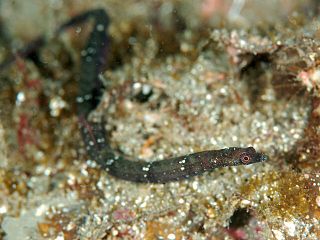
Halicampus is a genus of pipefishes of the family Syngnathidae, containing 12 described species.
Hippichthys is a genus of pipefishes native to the Indian and Pacific Oceans and the landmasses around them. This genus contains freshwater, brackish water and marine species.
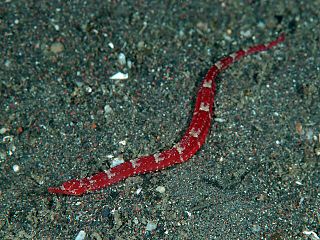
Festucalex is a genus of fish in the family Syngnathidae native to the Indian and Pacific Ocean.
The upside-down pipefish is a species of pipefish endemic to the coast of southern Australia, from New South Wales to Geographe Bay in Western Australia, where it is found in rocky reefs at depths of from 2 to 15 metres. It grows to a length of 9.2 centimetres (3.6 in) SL. This species is the only known member of its genus. Like other pipefish it is ovoviviparous but it may breed seasonally, as gravid males have been collected between September and November.
Hypselognathus is a genus of pipefishes endemic to Australia where they are only known from the southern coast.

Lissocampus is a genus of pipefishes mostly native to the Indian Ocean. One species (L. bannwarthi) is only known to occur in the Gulf of Aqaba and the Gulf of Suez and one species (L. filum) occurs in the Pacific Ocean around New Zealand and the Chatham Islands. The remaining species are endemic to Australia.
Micrognathus is a genus of pipefishes, with these currently recognized species:
Notiocampus ruber, the red pipefish, is a species of pipefish endemic to the Indian Ocean waters along the southern coast of Australia and Tasmania. It occurs at depths from 5 to 20 m over the continental shelf. This species grows to a length of 16.4 cm (6.5 in). This species is the only known member of its genus.

Vanacampus is a genus of pipefishes endemic to the ocean waters around the Australian coasts.
Maroubra perserrata, also known as the sawtooth pipefish is a species of marine fish belonging to the family Syngnathidae. This species can be found at depths up to 20 meters along the coast of Australia from southern Queensland to southern Western Australia. While they can live in many different habitats, they are often found inhabiting openings in reefs and rocks that contain algae and invertebrates, which they likely rely on for camouflage. Reproduction occurs through ovoviviparity in which the males brood eggs for roughly 22 days before giving live birth. Maroubra perserrata is considered more mobile than many pipefish species due to its prehensile tail and reduced caudal fin.
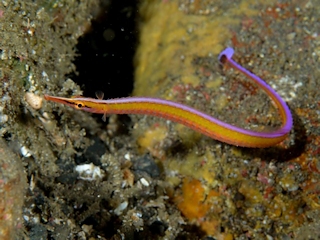
Maroubra yasudai, also known as the orange pipefish, is a species of marine fish belonging to the family Syngnathidae. This species can be found in the Izu Oceanic Park along the coast of Honshu Island, Japan. They often inhabit rocky crevices and caves at depths ranging from 28 to 30 meters. Their diet likely consists of small crustaceans such as copepods. Reproduction occurs through ovoviviparity in which the males brood eggs before giving live birth.












